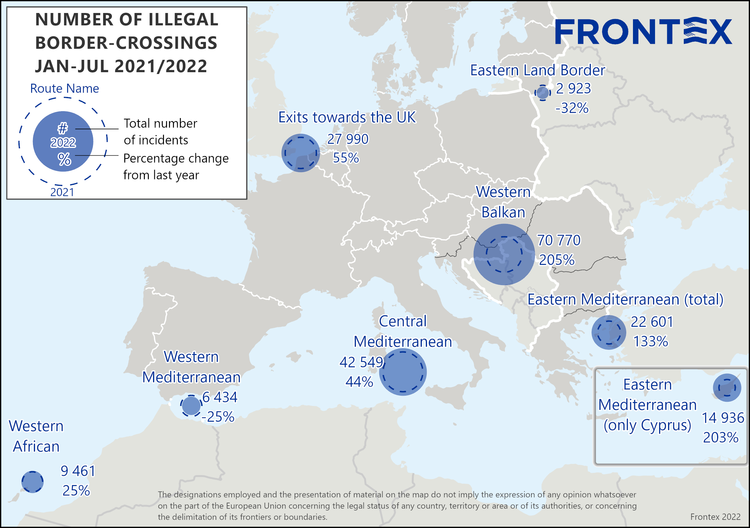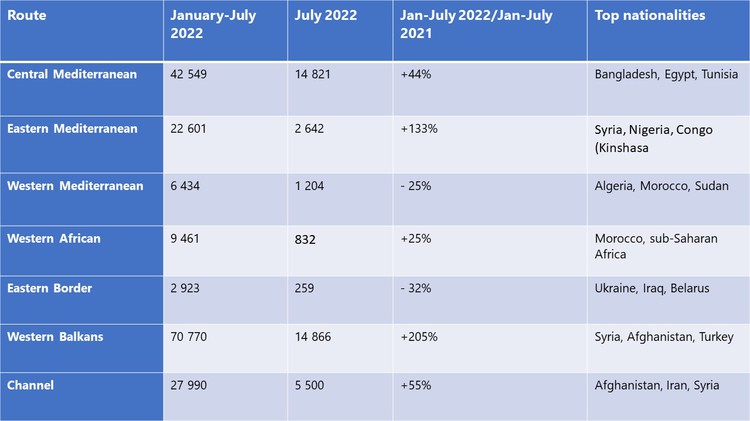In the first seven months of this year, there
were about 155 090 irregular entries to the European Union, according to
preliminary calculations. *
This represents an increase of 86% compared with the same period of last year.
In July, EU Member States recorded about 34 570
irregular crossings, 63% more than in the same month in 2021.
The Western Balkan continues to be the most
active migratory route into the EU with 14 866 detections in July, nearly three
times more than last year. The high number of illegal border crossings can be
attributed to repeated crossing attempts by migrants already present in
the Western Balkans.
The pressure remains also high on
the Central Mediterranean route with daily arrivals putting strain on the
reception capacities in Italy. Frontex supports the Italian authorities with
officers for registration and identification of arrivals.
People fleeing Ukraine and
entering the EU through border crossing points are not part of the figures of
illegal entries detected. According to the latest Frontex data, 7.7 million
Ukrainian nationals have fled Ukraine into the EU since the start of the war.
At the same time, a significant number of Ukrainian nationals have returned to
their country.
Responding to the high migratory
pressure, Frontex has more than 2 200 standing corps officers and staff at
various sections of the EU external border, as well as in Albania, Serbia,
Montenegro and Moldova.
January - July:
Top migratory routes
On
the Central Mediterranean route, Frontex registered 42 549 irregular border
crossings, 44% more than in the first seven months of 2021
Roughly 14 800 irregular border
crossings were reported on the Central Mediterranean route in July, 60% more
than in the same month of 2021. Albeit Tunisians (30%) were the top nationality
registered on this route in July, overall Egyptians slightly overpassed
Tunisians in 2022. The number of Egyptians detected on this route is on the
rise; they are departing mainly from Libya and are aided by criminal smuggling.
On
the Western Mediterranean route, 6434 irregular border crossings were detected,
down 25% from last year. Criminal smuggling networks attempted to use the calm
weather conditions to organise simultaneous departures using jet skis. Most
migrants detected on this route came from Morocco.
The
Western Balkan route accounted for half of all the detections with 70 770
illegal crossings, nearly three times the total from the same period of last
year. The main nationalities on this route included migrants from Syria,
Afghanistan and Turkey.
On
the Eastern land border route, Frontex registered 2 923 irregular crossings, 32%
down from last year. The main nationalities on this route were nationals of
Ukraine, Iraq and Belarus.
The
number of detections on the Eastern Mediterranean route remained high with 22
601 arrivals (more than double compared to last year). The number of arrivals to
Cyprus accounted for more than half of the total number of detections. Most
migrants came from Syria, Nigeria and Congo (Kinshasa).
The Western African route
recorded 9461 detections, 25% more than last year, with 832 crossings in July.
The
number of irregular migrants seeking to cross the Channel towards the UK in
small boats remained high with roughly 28 000 detections, including both attempts and
crossings, which represents a 55% increase on the same period in 2021. The
increase in sea crossings is mostly related to the improved seasonal weather
conditions and possible impact of the new UK migration plan.
*The figure includes other
less active migratory routes not mentioned in this press release. The final
figures may be higher due to delayed reporting.
Note: The preliminary data presented in this statement refer to the number of
detections of irregular border-crossing at the external borders of the European
Union. The same person may attempt to cross the border several times in
different locations at the external border.

